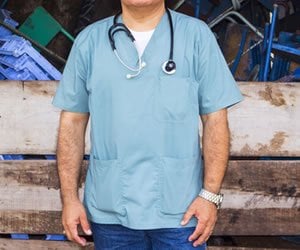Last Updated on June 27, 2022 by Laura Turner
Lucy Doyle, M.D., had never imagined that life after residency could be so hard. But as an internist working with the French-based Doctors Without Borders organization, she found herself the only physician in a small expedition party making its way to a village stricken by cholera. Although she was stationed at a nearby hospital, she and a team had set off through the jungle to help. “It was a two-day trek,” she recalls. “Walking through that jungle was the hardest thing I’ve ever had to do in my life.”
Midway on their journey, the expedition team ran into a couple carrying an infant son. The baby, a victim of the cholera outbreak, was unconscious and the desperate parents had decided to walk to the hospital for help. Fortunately, the hospital had come to them. “I took an IV from my bag and revived him enough so he could drink,” says Doyle. Extra fluids were given to the parents, along with instructions to keep their infant drinking as they walked. Then both parties continued on their respective ways.
A month later, Doyle returned to the hospital in time to see the infant just before he was discharged. “The difference was remarkable,” says Doyle. “When I saw him, his eyes were sunken in and he was not responsive. Now, he was a typical child, looking well and playing.”
Just another life-saving day in the world of medical missions.
Mind you, this kind of work is not for the faint of heart. But if saving lives, making a difference and practicing medicine in order to help— really help—people, then mission work may be for you. There are plenty of opportunities out there for physicians who want to lend a hand. Whether you want to travel abroad, stay stateside or work close to home, the need is there, and it’s never been greater.
Here are four ways you can help, both domestically and internationally.
Remote Area Medical (RAM) Volunteer Corps
Learn more: ramusa.org
When Stan Brock was a teenager, he worked for a time as a cowboy on a Brazilian cattle ranch that butted up against the Amazon rain forest. As the newest—and youngest—employee, Brock was given a horse to ride that was so wild it had been named Kang, the devil.
Kang had already thrown two previous riders by the time Brock mounted the horse. He would be the third rider to go flying off, sustaining substantial injuries in the process. The nearest hospital, however, was 26 days away—on foot. The nearest doctor was a three-day walk away.
Brock was young and tough and he recovered, but he never forgot the experience of being days away from medical care. That’s why he founded the Remote Area Medical (RAM) Volunteer Corps, which brings health care to those who live in remote areas of the world, including the U.S.
When Brock brings his pop-up clinic to an area, it’s always advertised well in advance, and the news spreads quickly. By the first day of the weekend-long clinic, hundreds of people are lined up at the gates.
“I’ll stand at the gate and ask how many people are here to see a dentist, and nearly every hand goes up. Then I’ll ask who needs to see an eye doctor, and there will be another show of hands. Next, I’ll ask who’s here to see a doctor and a few hands go up, but not as many as for the first two,” he says. “Now, all of these people need to see a doctor, and we schedule as many as we can, but they see their dental and eye needs as more important because those are conditions that affect them every day.”
Diabetes, hypertension and other serious illnesses haven’t made the same impact on their lives—yet. But it’s just a matter of time, says Brock.
Joseph Smiddy, M.D., would agree. As a pulmonologist, he has diagnosed emphysema, lung cancer, even black lung disease while working as a volunteer at RAM clinics.
“A lot of the areas we go into are coal-mining areas,” says Smiddy. But until recently, he and other colleagues had to depend on physical exams and stethoscopes to make their diagnoses. “I heard doctors say, ‘If only we could get a chest X-ray,” he recounts. So he decided to do something.
He bought an old tractor trailer and had it outfitted as a mobile X-ray unit, installing three state-of-the-art machines. “The clinics all use modern equipment, I want to emphasize that,” says Smiddy. “We don’t use old, hand-me-down equipment.” When the unit was road ready, Smiddy then carved 180 hours out of his busy practice time to obtain a tractor-trailer driver’s license so he could drive the unit himself to RAM clinics and other volunteer and community events.
Not every RAM volunteer rises to that level of dedication, of course, but a certain level of dedication is required of all RAM volunteers. For example, if you’re traveling to the clinic from out of state or elsewhere in the state, you’ll arrange for and pay your own transportation and lodging. And prepare to be at the clinic the whole day.
“We don’t do shifts,” says Brock. Everyone reports for work by 6:30 (the clinic opens at 5 a.m. for registration), and you’re likely to be there until 7 or 8 at night. All specialties are needed, although oral surgeons and ophthalmologists are most in demand.
If you decide to lend RAM a hand, you’ll need flexibility, endurance and a willingness to roll up your sleeves and pitch in for almost anything. You’ll also need a current medical license (and therein lays the rub for physicians who want to volunteer stateside).
“We need a federal law that allows doctors who volunteer in other states to do so without first obtaining a medical license in that state,” says Brock. He has testified before Congress on the matter, but although some states have passed “Good Samaritan” laws, as they’re known, not all states have and there has been no federal action on the issue. The American Medical Association has put together a state-by-state list of requirements for senior physicians who want to volunteer, and it’s probably the best of the resources out there.
All in all, says Smiddy, the experience will be worth it. Yes, he admits, it comes with a level of frustration that you can’t do more, but you’ll meet real people with real needs, and experience the feeling of actually helping these individuals. “That’s the reason I went into medicine,” he says. RAM is a good entry into medical volunteerism, he adds, “and it’s personally rewarding.”
To read the rest of this PracticeLink content, including descriptions of three more mission medicine opportunities, please visit PracticeLink.com.



